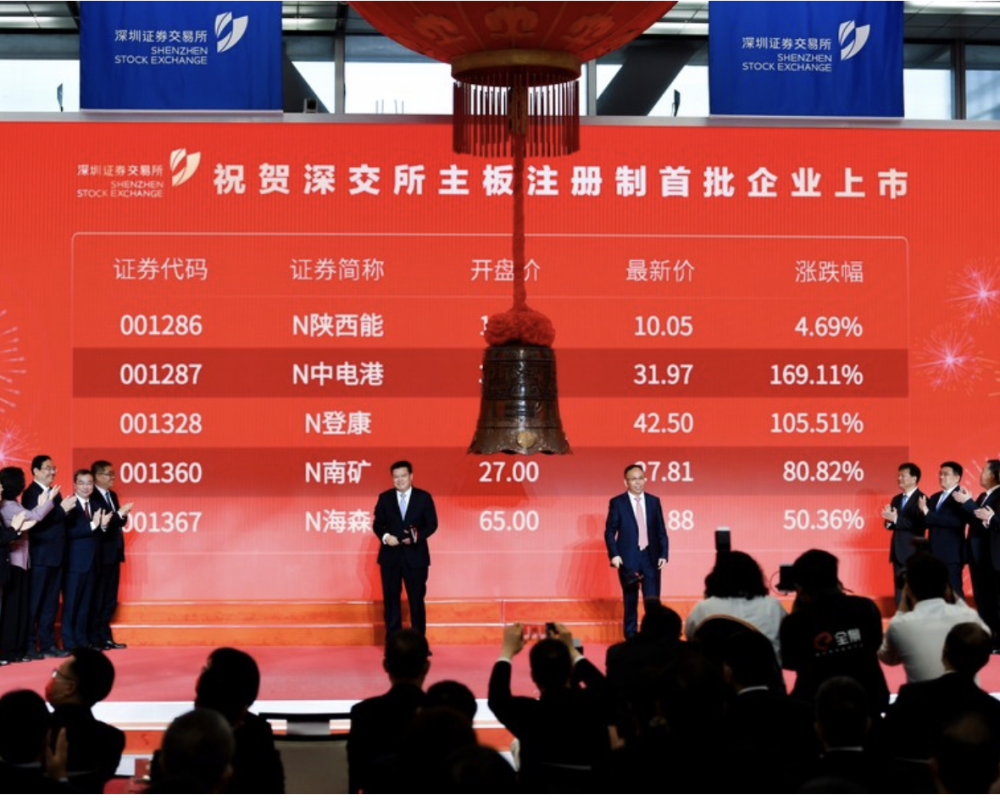
This photo taken on April 10, 2023 shows the ceremony celebrating the listing of the first batch of shares under China's registration-based initial public offering (IPO) system on the main board of Shenzhen Stock Exchange in Shenzhen, south China's Guangdong Province. (Xinhua/Mao Siqian)
BEIJING, June 9 (Xinhua) -- While the world economy faces mounting uncertainties, international capital remains assured by the investment opportunities generated by China's long-term economic fundamentals.
Foreign capital has continued to flow into China's stock market, with a net influx of 170 billion yuan (23.9 billion U.S. dollars) through stock connect programs in the first five months, the latest official data show.
There are plenty of reasons to invest in yuan-denominated assets. Their low correlation with other risky assets can help investors achieve risk diversification while capturing potential upside opportunities. The valuation of RMB assets is still at a relatively lower level. The scale of the world's second-largest capital market and its improved liquidity also strongly appeal to global investors.
Admittedly, the Chinese economy still faces the triple pressure of demand contraction, supply shocks, and weakening expectations amid an increasingly complicated external environment. But insightful investors know full well that the long-term prospects for China as a major investment destination have not changed.
The economic recovery after the COVID-19 response shift is still going on. In April, China's retail sales of consumer goods surged 18.4 percent year on year, 7.8 percentage points higher than that of March.
The pent-up demand of over 1.4 billion people can't be ignored, and the strength of consumption will continue to shore up the country's future growth as an expanding middle-income group continues to favor travel and entertainment, higher quality goods and better health care.
Resilience can be seen in other areas. Though overall manufacturing activity slowed in May, the sub-indices of activity gained in some major sectors such as equipment manufacturing, high-tech manufacturing and consumer products industries.
Against the backdrop of stuttering global trade, China maintained a 4.7-percent year-on-year growth in foreign trade of goods in yuan terms in the first five months, a hard-won achievement.
With a huge and vibrant market, sound industrial system and efficient governance, China will be an undisputed bright spot in the global economy this year.
The latest reports issued by the World Bank and the Organization for Economic Cooperation and Development (OECD) both noted that China's reopening will provide impetus for global economic growth. The World Bank predicted that China's economy will grow by 5.6 percent in 2023 and the OECD set this figure at 5.4 percent.
China's policy pendulum has also swung toward the pro-growth side. Monetary and fiscal policies will continue to play a major role in consolidating recovery, boosting the confidence of investors in the country.
As the Chinese economy gathers pace toward technology-driven and greener growth, its capital market provides global investors with the opportunity of investing in some of the world's fastest-growing and most promising companies in such sectors as technology innovation and renewable energy.
Over the past five years, foreign investor holdings on the ChiNext board, China's Nasdaq-style board of growth enterprises, surged more than 11 times. In 2022, the high-tech manufacturing enterprises in China registered a combined revenue increase of 14.6 percent and an R&D intensity of 6.71 percent.
China's capital market is more open and market-oriented than ever before. At a difficult time when unilateralism and protectionism are rearing their ugly heads, a string of reforms have testified to the country's commitment to opening up. This includes the newly launched Swap Connect, an interest rate swap market access scheme between the Chinese mainland and Hong Kong.
In a nod to the market's attractiveness, major global benchmarks like MSCI, FTSE Russell, and the S&P Dow Jones have included the A-shares and strengthened their weightings. China's government bonds also made their way into major global bond market indices.
With the scrapping of ownership caps for foreign institutions for securities, futures and funds, many global financial institutions have expanded their footprints in China. Morgan Stanley, as the latest example, is to set up a futures unit in China.
These facts, amid the clamoring for the so-called "de-risking" from China, have sent a clear signal that global investors remain confident in China's long-term growth even at this challenging time.
If foreign investors exclude China from their portfolio, they risk missing out on the huge potential of this rewarding market. The more one buys into China, the more opportunities they will share in its sustained and quality growth. ■